National Yo-Yo League Freestyle Rules
Freestyle Judging
Performance Time
Final Freestyle: 2 minute freestyle routine to music of their own choosing.
The freestyle time begins to run at the moment the music starts. The music will be stopped between 2:00 and 2:01, regardless of whether the beginning of the song is silent. If the song is shorter than 2 minutes, the music will stop at the end of the track.
In the case of a music issue such as an audio equipment malfunction occurs mid-freestyle, the contestant may choose to continue the freestyle for the rest of the 2 minutes. The contestant may also choose to stop and restart the routine after the issue has been fixed. If the contestant decides to stop the freestyle routine due to a music issue, with taking the audio equipment and CD condition into consideration, the contestant can discuss with the head judge and make a decision from the following.
- Restart evaluation from where the music has stopped (If Group A judges have not reset the clickers)
- Restart evaluation from the beginning (Can be restarted immediately or can be performed at the end of that division)
- Take the evaluation up to the point where the music has stopped as the contestant’s final score, without restarting the evaluation.
A contestant is not permitted to play yo-yo on the stage before the music starts. Also, they cannot start their freestyle with a mount or sleep before the music starts. The performance must start with the yo-yo in the contestant’s hand. We request that contestants refrain from yo-yoing of any kind during the standby time between getting on stage and when the performance begins. In addition, adjusting standby yo-yos is not permitted, and should be taken care of before the contestant gets on stage.
When the 3 minutes performance is finished, the contestant must immediately stop playing. At the end of the freestyle, if the contestant is unable to rewind the yo-yo(s) back to their hand(s), they will receive a deduction. This and other negative points will still be counted until the contestant stops the yo-yo, or otherwise leaves the stage. Actions by the contestant that give the impression of the end of the performance (bowing, etc.) will be considered to indicate that the freestyle is over. In the case that the contestant resumes play after that action, deductions will be applied.
In the case of the music being stopped or ending before the planned music duration, the contestant must immediately notify the contest staff or the judge. Restarting the evaluation cannot be requested after the results have been announced. On the other hand, if the music continues to play after three minutes, and the contestant continues to perform more than three minutes, the contestant may be subject to disqualification. The contestant is responsible for understanding the duration of their music, and ending the performance within three minutes.
Note Regarding Music Issues for Contestants:
If the music starts and the volume is too low, the track starts in the wrong place, or the wrong music is played, the contestant must immediately stop the performance and notify the on-stage staff or judges.
If there are any actions by the contestant (ex. bowing, appearing to leave the stage, appearing to stop the performance) or indications in the music (ex. the track appearing to end, or an extended period of silence) within the three minutes which may give the impression of the performance ending, the judge or the contest staff may determine that the performance has ended. If such actions or music characteristics exist in the contestant’s performance, we request that the contestant speak with the contest MC, music staff, and judges on the day of the contest, before the performance. This information will be shared with the necessary contest staff to avoid any confusion
Music Guidelines & Upload
For information regarding Music Upload please visit this link:
http://contest.nationalyoyo.org/freestyle-judging/music-guidelines/
Contestant Code of Conduct
All contestants must conduct their freestyle with the safety of the audience, the venue, the equipment, and themselves in mind. Contestants performing in an unsafe manner may be disqualified at the discretion of the judges.
The head judge also reserves the right to immediately disqualify a contestant who behaves or speaks in an inappropriate manner on stage. This includes uttering obscenities, wearing inappropriate or obscene clothing, and any acts of public indecency.
In the case that a contestant is unsure whether their planned actions on stage are appropriate, they should consult a judge beforehand to avoid disqualification.
For the sake of safety and fairness, contestants are not allowed to leave the stage during their freestyle. If a contestant leaves the stage, that moment will be considered the end of the performance. This includes leaving the stage to pick up a yo-yo that has fallen from the stage.
Due to the potential hazard of falling off the stage, sitting or standing over the edge of the stage is also prohibited and subject to disqualification.
During a freestyle, only the contestant is allowed on stage. Assistants to the contestant are also prohibited during the performance.
Disturbing contestants (through shouting, taunting, or other inappropriate actions) before, during, or after their freestyle is strictly prohibited, and may result in the disturber’s disqualification or barring from entering future contests in the league.
Yo-Yo Rules
There are no special restrictions on the manufacturer, type, parts or modifications used for a freestyle yo-yo.
Safety is still a prime concern, so any modifications that compromise the safety of the contestant, venue, or audience may result in disqualification.
Strings used must be string for the exclusive use of yo-yoing. In the case of styles that require special string, (Go West, Long String, Transparent String, etc.), it may be used only with the prior consultation, safety confirmation, and permission from judges
A contestant may only use the yo-yos they personally bring with them on stage. During their freestyle, a contestant may not receive or use yo-yos from audience members. In divisions including (but not limited to) 4A and 5A, if a yo-yo falls off the stage, it may no longer be used. Even if a yo-yo is returned to the stage by an audience member with good intent it may not be used. In the case that a contestant uses that yo-yo, positive points will not be scored during its use and negative points will continue to be subject for deduction.
Contestants are required to use their yo-yo(s) as a yo-yo.
In the case that a contestant performs in a style that is not subject to their division, that part of the performance will not be scored (however, negative points may still be applied). For example, if off string elements are used in any other division than 4A they will not receive points.
Due to the yo-yo tangle or yo-yo change (discard) you can use more total yo-yos than allowed below.
Below is a list of the number of yo-yos that can be used simultaneously during freestyles for each division:
- 1A – 1 yo-yo
- 2A – 2 yo-yos
- 3A – 2 yo-yos
- 4A – 1 or more yo-yos
- 5A – 1 or more yo-yos
In the case that yo-yos exceeding the permitted number are used (or held) simultaneously, all tricks subject to scoring and evaluation will not be counted.
Non Yo-Yo Items
The contestant is only allowed to bring yo-yos, strings, counter-weights, gloves (or equivalent items), a backup music CD for competition, and a tray provided by contest officials onto the stage. Maintenance tools, performance props, and any other items are strictly prohibited. This includes (but is not limited to) items such as bags, cases, cloth, jackets, extra clothing (other than what the contestant is already wearing), and tables. Contestants bringing prohibited items to the stage are subject to disqualification. However, for the purpose of protecting valuables (such as a bag, wallet, cellular phone, etc.), a contestant may leave their belongings at the side of the stage, but is prohibited from interacting with them.
Freestyle Scoring
Freestyles will be graded on three criteria: Technical Execution (T.Ex), Technical Evaluation (T.Ev) and Performance Evaluation (P.Ev).
Judges are assigned into two groups:
- A Group: Technical Execution (T.Ex)
- B Group: Technical Evaluation (T.Ev) and Performance Evaluation (P.Ev).
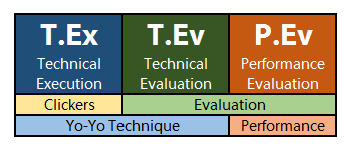
Technical Execution (T.Ex) – 60%
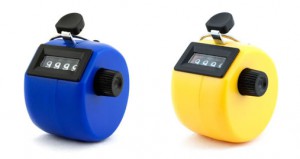
Each judge uses two clickers, one each for positive and negative points. These are added together for the final T.Ex score, which is 60% of the total possible score.
Judge takes only succession, difficulty, risk and variation of each trick performed.
Originality, amplitude, long-sleep, continuity, uniqueness, style, choreography are NOT subject to be scored here.
Definition of divisions
- 1A: Freestyle with one string trick yo-yo(Moves are based on touch and mount between yo-yo and string)
- 2A: Freestyle with two looping yo-yos(Moves are based on making circles with yo-yo trajectory)
- 3A: Freestyle with two string trick yo-yos(Moves are based on touch and mount among two yo-yos and two strings)
- 4A: Freestyle with yo-yo(s) which string is not attached(Moves are based on tricks which are possible because the yo-yo is not attached to the string)
- 5A: Freestyle with yo-yo(s) which has counter-weight on the other side of string(Moves are based on tricks which are possible because the yo-yo has counter-weight)
Positive Points (Technical Execution via Clickers)
When the contestant performs advanced level trick elements, points will be given for each element.
All points are given per trick element.
Here are some examples of trick elements in each division.
1A Division:
- Mount (Trapeze)
- Hop (Eli Hop)
- Laceration (Hook)
- Release Catch (Suicide Catch)
- Whip Catch (Iron Whip, Slack Trapeze)
- All other appropriate moves for 1A Division that come with a certain difficulty.
2A Division:
- Looping (Loop, Hop)
- Moon (Reach for the Moon, Planet Hop)
- Wrap (Loop Wrap, Sleep Wrap)
- Tangler
- Around the World
- All other appropriate moves for 2A Division that come with a certain difficulty.
3A Division:
- Rolls (Velvet Rolls)
- Kink (Kink Fu)
- Trapeze (2-Hand Trapeze)
- Assisted
- KoroKoro
- All other appropriate moves for 3A Division that come with a certain difficulty.
4A Division:
- Whip (Over Whip, Open Whip)
- Recapture
- Boingy Boingy
- Toss
- Orbit (Around the Arm, Orbit the Leg)
- All other appropriate moves for 4A Division that come with a certain difficulty.
5A Division:
- Direction Change (Shoulder Pop)
- 360
- Propeller
- Bee-sting
- Aerial (Meltdown Jump)
- All other appropriate moves for 5A Division that come with a certain difficulty.
Tricks such as Gerbil and Rancid Milk are seen as a group of trick elements not as a trick and each trick element is scored individually.
Generally, the same trick elements performed in a freestyle will not be scored the second time. However, high risk repeating trick such as Suicide combo, or same trick elements in a different trick combo can be scored the second time with some reduction of base points given for the trick element.
Negative Points (Technical Execution via Clickers)
Any trick miss and control miss is subject to deduction.
Negative 1:
Trapeze miss, control miss, catch miss, corkscrew in looping.
All deductions are counted per yo-yo. If the contestant has a mistake in each hand (with two yo-yos), the contestant will receive two negative points.
Yo-Yo stop, or yo-yo change will be counted in Major Deduction stated below.
Technical Evaluation (T.Ev) – 20%
Judges (Group B) evaluate four categories from 0 to 10 points, total 40 points, then they will be halved to make the 20% of the final score. They will not be normalized between judges. Entire three minute performing time is subject to evaluation.
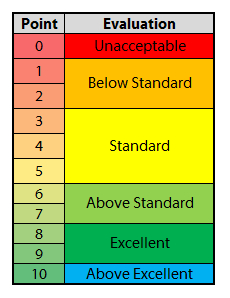
The table above is a basic grading guide.
The following are the four categories to be scored as Technical Evaluation.
1. Cleanliness (CLN)
(Control of Yo-Yo/String, Line of String, Trajectory of Yo-Yo, Smooth landings and flowing transitions)
Are the tricks executed in a clean, fluid and controlled manner?
Do the transitions into and between trick elements demonstrate mastery and control of the yo-yo style?
Does the yo-yo land and exit the string cleanly?
Is each trick well-practiced to the level of mastery?
Were tricks maneuvered smoothly?
Were the tricks refined to be seen?
# It is not about how smooth the routine is, nor the number of mistakes. It is simply how good the control of yo-yo and string is.
2. Variation (VAR)
(Different techniques within the style of play, Variety of trick styles):
Does the routine have a well-balanced mix of trick styles?
(The player should not keep showing the same kinds of tricks too long.)
Was each trick style mastered well at a sufficient level?
3.Rareness (RAR)
(Uniqueness, Originality, Creativity, Newness, Unusualness of tricks)
Does the player demonstrate an original or unique, unusual tricks, moves, or elements from all other contestants in the current contest scene?
Does the player have unique, original, creative tricks, style, or trick elements?
(The player should not fill the routine with common, ordinary tricks, moves.)
Did the player perform any new, unusual, creative tricks, elements?
# It does not require that those tricks are made by the player, nor never seen at all.
Same with all other criteria, doing simple picture tricks (like Tower or Rock the Baby) or looping in 1A do not earn any points here. (Need to be sufficiently difficult. Need to be within the division’s realm.)
4. Execution (EXE)
(Success Rate of Tricks, Succession, Less mistakes, Completion)
How few are the mistakes?
Is the routine performed as planned?
# It is not about the mastery or perfection of each trick. It is about the completion of all tricks. If the entire routine went well without any mistakes, it will have a full score. Even if the tricks are smooth and well-practiced, if the player has many mistakes, it will be low. Also it does not require any difficulty or risk to be seen as full score. It is evaluated as perceived by the judges.
Performance Evaluation(P.Ev) – 20%
Judges (Group B) evaluate four categories from 0 to 10 points, total 40 points, then they will be halved to make the 20% of the final score. They will not be normalized among judges. Generally, the entire three minute performing time is subject to evaluation. However, even before and after the three minutes, any inappropriate action or devaluation will be counted for the categories.

The table above is a basic grading guide.
The following are the four categories to be scored as Performance Evaluation.
1. Music Use (MSC)
Choreography, Hitting Music Cues, Rhythm/Beat, Imagery/Atmosphere:
(Necessity of Music, Music Timing)
Does the music seem to fit the freestyle theme?
Are the tricks timed to match the beat of the music?
Is there any cueing or choreographic points?
Are body moves and tricks matched with the music?
2.Body Control (BDY)
Stage Manners, Posture, Stage Professionalism, Attitude:
(stage presence/composure, Moves of body)
Does the player demonstrate a mature professional presence before, during and after the freestyle?
Does the player demonstrate total control of all aspects of the performance?
Is the contestant aware that he/she is on stage and being seen?
Are body moves well refined?
Does the contestant appear to be confident/professional?
Was the show appropriate to be seen by a general audience?
# Sticking tongue out, tilting head when making a mistake, or making a bitter face in hard time, and ignoring the audience unintentionally are all considered to be bad examples for this category.
3.Space Use (SPC)
Largeness, Amplitude/Focus, Size of Yo-Yo Moves, Stage Use:
(Size of expression, moves, performance, Effective use of stage and space, and/or focusing on/into a subject effectively)
Does the contestant use the stage and space effectively?
Is the trick performed big and easy-to-see?
Were the small moves or subtle actions focused to gather the audience’s attention?
4.Showmanship (SHW)
Theme/Story, Enjoyment, Entertainment, Overall Impression of Show:
Was the performance staged and constructed in a manner to add to the interest level of the freestyle?
How entertaining was the freestyle presentation?
Does the freestyle have a story or theme?
Is there any effective usage of an outfit?
Is it a performance to attract and entertain the audience?
# Interesting or Entertainment Value that comes from pure amazing yo-yo skill will not be counted here. Added work toward making the freestyle interesting (Showmanship) on top of the yo-yo tricks and skills is required here.
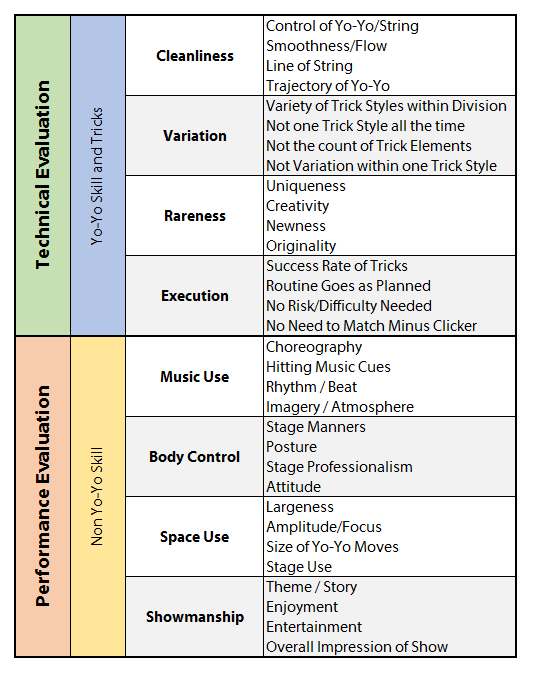
Major Deductions (MD)
These deductions will be subtracted after all the scores above are summed.
Yo-Yo stop (restart), Yo-Yo discard (change), Yo-Yo detach (string cut) and dangerous play will be subject of this deduction.
Yo-Yo Stop (Restart) – Minus 1
Any stop of yo-yo spin with string fully unwound will be subject. Even if the yo-yo does not stop completely, if you need to help the yo-yo to regain its spin with your hand or string, it will be considered as a yo-yo stop. However, contestant can hand-wind yo-yo with half-wound string or add more spin to the yo-yo spinning fast enough to be able to wind by itself without this deduction. Any intentional or planned yo-yo stop will be seen as a yo-yo stop with the deduction. After the yo-yo stops and the contestant adds the spin to the yo-yo then fails to wind and it stops again, it will be counted as another yo-yo stop to be deducted.
Yo-Yo Discard (Change) – Minus 3
Any yo-yo discard will be subject. Leap of 4A and 5A yo-yos, or any yo-yo change or stop using the yo-yo will be counted. Even if the contestant comes back to the yo-yo to reuse it, if the contestant uses another yo-yo once, the yo-yo discarded will be counted. Any intentional or planned yo-yo change will be counted as a yo-yo discard. However, if the discard happens after the yo-yo stops in one instance, only the discard will be counted and not a yo-yo stop. However, if the contestant tries to restart before the yo-yo change, both a stop and a discard will be counted. If you want to show both tricks with 1 and 2 yo-yos in 4A or 5A without any deductions, you need to show 1 yo-yo tricks first, then add another yo-yo to show 2 yo-yo tricks.
When the Performance Ends
If the contestant cannot make the yo-yo come back to the hand fully wound and ready to throw, both a stop and a discard will be counted as a discard (minus 3). The string can have knots or be jammed, yet it needs to be fully wound to avoid the deduction.
The contestant is expected to complete the routine before the music ends. If the music ends while tricks are still being performed, the contestant should stop the trick and wind the yo-yo. (However, the moves required to get out from the shape to wind will be allowed if the yo-yo is still spinning.)
After the music stops, if the contestant fails to wind the yo-yo due to a yo-yo stop, it will be counted as a discard. Also at the moment the music stops, if the yo-yo is not spinning and requires a restart it will be counted as a discard.
If the contestant does not have a yo-yo in their hand ready to throw, for example: a yo-yo is in their pocket, on the floor, in the hat, or string detached from the finger like after Rocket, all will be seen as a discard.
All Performance End Deductions will be the same, even if the contestant decides to end their routine before the music ends.
Yo-Yo Detach (String Cut) – Minus 5
Any dangerous play or any play that can cause any damage needs to be avoided at all cost. Therefore, judges will be very strict to those actions even if it is unintentional.
Yo-Yo coming apart, string cut, or string detach for 1A, 2A, 3A, 5A (yo-yo and weight both) will be counted as a Yo-Yo Detach (Minus 5). Any intentional string cut like “Break the String” trick will be the same. However, unscrewing by hand to fix the string while the yo-yo is not spinning will be allowed without the deduction. Changing yo-yo(s) after a String Cut will be counted as only a Yo-Yo Detach (Minus 5), not both penalties at the same time (Minus 8).
Flying Off – Disqualified
Including 4A and 5A, if any yo-yo jumps into the audience area behind the judges’ table will be subject to disqualification. This will be discussed after the routine is over.
A Yo-Yo jumping into the audience with enough speed, height or dangerous trajectory will be subject. Even if the yo-yo bounces on the stage once, it will be seen as the same. A Yo-Yo rolling off from the stage will be allowed without disqualification.
All those deductions are per yo-yo/string. If two yo-yos are tangled in one incident and need to be changed, it will be 6 point deductions (3 point x 2 yo-yos).
At the same time, any mistake or loss of control is counted as a deduction in Technical Execution, separately from Major Deductions.
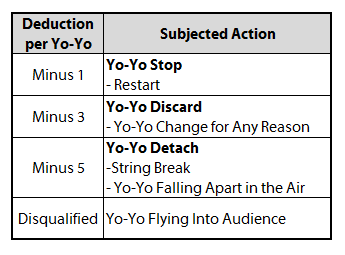
Final Score
Final Championship Freestyle Score is calculated by adding all scoring components:
- Technical Execution (60.00-points maximum) plus
- Technical Evaluation (20.00-points maximum) plus
- Performance Evaluation (20.00-points maximum) minus
- Major deductions.
Technical Execution will be normalized (to eliminate the unevenness among judges and let them have the same portion to contribute to the score). All other scores will not be normalized.
Depending on the judges’ availability and skill, the counter(s) of Major Deductions can be different by contest or division.
Criteria and Scoring for Preliminaries
The final score will be the sum of these four categories.
- Technical Execution (60.00-points maximum) plus
- Technical Evaluation (20.0-points maximum) plus
- Performance Evaluation (20.0-points maximum) minus
- Major deductions.
Technical Evaluation (T.Ev) 20%
- Cleanliness (CLN)
- Execution (EXE)
*Note: Simplified Categories from Finals Scoring Criteria.
Performance Evaluation (P.Ev) 20%
- Music Use (MSC)
- Body Control (BDY)
*Note: Simplified Categories from Finals Scoring Criteria.
In The Case Of A Tie:
Judges will determine the winner with the descending order of T.Ex, T.Ev, and P.Ev. If after comparing all three numbers and there is still a tie, the judges will call it as a tie or suggest a better solution.
The judges’ decision is final.
All contestants are expected to read and understand the entire rules above.
